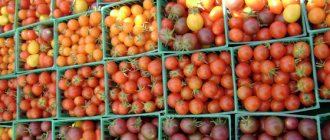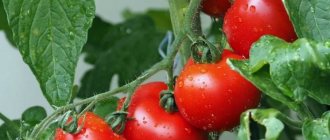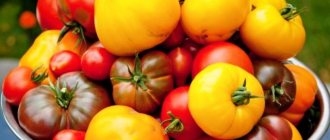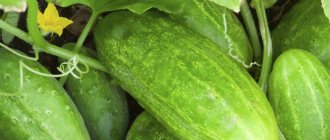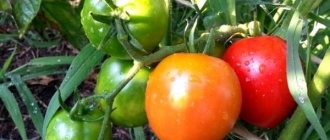Many people are accustomed to the fact that eggplants are purple. They are even often called “little blue ones.” And colorists will easily describe the eggplant shade as belonging to the lilac range. However, breeders have long since destroyed these stereotypes by developing varieties of white eggplants. Among them there are many that can be cultivated in all regions of Russia, even in open ground.
What are the benefits of white eggplants?
In pursuit of novelty and the creation of the “ideal” vegetable, breeders developed eggplants with white skin. Its pulp is tender, juicy, elastic and practically without seeds. The main difference from its purple counterparts is the lack of bitterness in the skin . There are a couple of dozen varieties and hybrids in the assortment of “white ones”; they are similar in taste, but differ in shape, ripening period and size.
Features of white eggplants:
- They don't need to be soaked.
- They do not accumulate harmful substances.
- Tastes better.
- Rich mineral and vitamin composition.
- Low calorie content.
- Does not contain solanine (a toxic substance).
Despite the hefty list of positive qualities, the vegetable should not be overused, especially by people with iron deficiency anemia and kidney disease, because eggplants remove iron from the body and contain oxalic acid.
How to choose seeds for planting?
All varieties are similar in taste, but bear fruit at different times; residents of the northern regions, where summers are short, should pay attention to this. To harvest before the onset of cold weather, you should give preference to early hybrids that ripen in 70–90 days. The proven variety is chosen as the main one, and new ones taken for testing as auxiliary ones for a variety of shapes and tastes.
In agricultural technology, white varieties are not much different from blue ones. They love moisture and fertile soil, but need higher air temperatures and are stored for only a couple of days after collection, after which they begin to deteriorate. The purchase of seeds is carried out in a specialized store that has certificates and a wide selection of products. When reading the description of the variety, pay attention to the expiration date of the package; expired seeds do not germinate.
Important! The selected variety must be suitable for the climate of the region and cultivation in open or closed ground.
Multi-colored radishes
It turns out that radishes don’t have to be bright red, because there are many varieties with pink, white, yellow and even purple fruits. And if you want to conduct an experiment to get an early unusual harvest of vegetables, then pay attention to these varieties:
- Marshmallow. An early variety with snow-white colored fruits. Ripens within 20-25 days from sowing. Its round-shaped fruits reach a weight of 25 g.
- Amethyst. The variety is distinguished by its rich purple peel color. It ripens within 25 days from sowing. The fruits reach a weight of 20 g and have good keeping quality. They can be stored for up to 2 months.
- Watermelon. This variety is distinguished by its larger fruit size. Their peel is painted in light green tones, and the flesh is a rich crimson color.
The best variety is the key to a generous harvest
There are few hybrids in the plant assortment that are suitable for open ground conditions, but even in such a variety the best can be identified. The presented varieties have a similar taste, but differ in ripening time, color (snow-white or milky), and size. Despite this, they are all good at cooking and preparing winter preparations.
| Name | Ripening period | Description | Photo |
| Bibo F1 | Early (85–90 days) | The bush is medium-sized - up to 90 cm in height, the fruits are oval, oblong (18 cm long), weighing 300–350 grams. The main shade is white without a glossy sheen. The variety grows quickly, bears fruit well, tolerates the incidents of nature, and is stored and transported for a long time. Has strong immunity | |
| Icicle | Mid-early (110 days) | The height of the plant reaches 70 cm, the fruits are cylindrical and weigh up to 200 g. The color is snow-white, the flesh is tender and juicy. Productivity is stable | |
| Snow | Early (106 days) | The bush is 90 cm high, the stems and shoots are pubescent, there are many ovaries. Vegetables reach an average of 320 grams and have an elongated cylindrical shape. The flesh is firm but not tough | |
| White Night | Early ripening | The bush is spreading up to 80 cm high, has up to 6–9 fruits. Drop-shaped vegetables, up to 270 grams in weight. Full maturity occurs on day 105 | |
| Taste of mushrooms | Early | The variety is resistant to diseases and can be grown in central Russia. Productivity up to 6 kg per 1 sq. meters. The fruits are small, cylindrical, average weight 180 g. The flesh is tender with a mushroom flavor. Snow-white peel | |
| White Lily | Early | The most productive variety with a powerful root system. Oval-shaped vegetables up to 400 grams. The skin is thin, snow-white. The pulp is also light, with a pleasant taste. High resistance to diseases | |
| Stork | Early ripening | The variety ripens quickly and when ready for harvest acquires a yellowish tint. When kept for longer than 90 days, the pulp thickens and becomes tough. Fruits weigh up to 100 grams, shaped like an egg | |
| Swan | Middle term | Full maturity occurs on day 116. The variety can be grown in open ground and in greenhouses. Eggplants are cylindrical up to 20 cm long. The color is snow-white. Productivity is high | |
| Ping Pong F1 | Mid-season | The most unusual variety. Its fruits become spherical and creamy in color. Average weight 90 grams. The pulp is white, tasty | |
| Pelican F1 | Average | The bush is compact, with light green foliage. Ripening occurs on day 115. The vegetables are of a rather exotic shape, similar to the nose of a pelican: oblong and slightly curved. Length up to 20 cm, weight - 300 g |
In addition to the main varieties, good performance of the hybrids “Tender F1” and “Egg-shaped” was noted. Eggplants are suitable for boiling, stewing, frying and canning.
Baby White
The variety is admired for its fertility, but it is preferable to grow it in small containers. The height of the bush reaches 55 cm, the stems are pleasingly lacking thorns. Purple flowers add decorative value to vegetable bushes. The fruits are oval-shaped, creamy-white in color. The soft-tasting pulp is snow-white in color and has a delicate aroma.
It is recommended to soak the seeds in a growth stimulator for several hours before planting. After which they are dried and sown in a moist peat substrate to a depth of 1-1.5 cm. The seedlings are planted in separate containers. The plant is moisture-loving and requires regular, abundant root watering.
Growing in open ground
Cultivating white eggplants is not particularly difficult, but not all gardeners undertake to grow them. The plant requires nutritious, loose soil, abundant watering and fertilizing, and for speedy fruiting, seedlings are grown in open ground.
Good yields were observed in sunny, wind-protected areas and on moist soils. The only difference from their blue counterparts is the increased air temperature (+25 degrees and above). For temperate climates, it is worth choosing cold-resistant varieties, because at the end of May there is always a risk of spring frosts, which will lead to loss or damage to young seedlings. To protect the sprouts, use polycarbonate greenhouses or film covers.
Preparing seedlings
Already at the end of February you can buy seeds and start germinating seedlings. To do this, you need to prepare the planting material by soaking it in a weak solution of potassium permanganate with the addition of a few drops of a growth stimulator. After a couple of hours, sowing is carried out in the ground. Purchased seeds have already gone through all stages of processing, so there is no need for such a procedure.
The container chosen is spacious and voluminous, because eggplants do not tolerate picking well and need a constant container to grow. Clay or plastic pots, boxes, and peat tablets are suitable for this.
Use ready-made purchased soils as soil or prepare the mixture yourself, for this you take:
- Garden soil - 2 parts.
- Humus - 1 part.
- River sand - 1 part.
- Ground eggshells.
All ingredients are thoroughly mixed, drainage is poured into the bottom of the container and filled with soil, after which the seeds are planted. The grains are buried 1.5-2 cm and the soil is moistened, then the container is covered with glass or film and left in a warm and well-lit room for germination. Every day the covering is opened slightly to ventilate and remove excess moisture (condensation) to prevent mold from forming. After 5–7 days, the first shoots will appear.
To germinate seedlings, the air temperature in the room is maintained at +25–28 degrees.
After germination, the covering is removed, but a suitable temperature and humidity are maintained, watering the seedlings abundantly. When the fifth leaf is formed, water it daily in the morning with warm water.
Picking and fertilizer
If the seeds were planted in a common container, you will have to pick - transplant the sprouts into separate pots. This process is quite troublesome and brings a lot of stress to young seedlings, but it must be done, otherwise the seedlings will stretch out when thickened and disappear.
The method of transshipment, in which the roots are not touched, but are transplanted with a clod of earth from the previous container, will help improve adaptation. Plants emerge when the second true leaf forms, water and shade slightly, protecting from direct sunlight.
After a week, fertilize the soil with mullein solution in a ratio of 1:4 or use a mixture:
- 5 liters of water.
- 6 grams of potassium salt.
- 10 grams of ammonium nitrate.
- 10 grams of superphosphate.
Repeated feeding is done after 10 days, increasing the amount of ingredients by 2 times (except water). If the solution gets on the leaves, they are thoroughly washed with water to avoid burns.
Transplanting to beds
At the end of May, they begin to harden the plants; for this, the pots are taken outside for a few minutes, increasing the “walk” time every day, and lowering the temperature in the room. The number of waterings is also reduced to a minimum. Before planting in the garden, it is recommended to spray with Bordeaux mixture to protect against pests and diseases.
Choose a site that is sunny, protected from drafts and sharp gusts of wind, with fertile, moist soil. Plant seedlings in the evening or morning, or even better in cloudy weather, so that the plants do not wither in the sun. The distance between holes should be at least 30–40 cm, and between rows – 60–70 cm.
Planting is done on ridges, in holes or rows, while carefully watering the seedlings. The bushes need abundant mulching so that the moisture does not erode and the roots do not suffer from the sun and heat.
Care and protection from pests
During the first week after planting, plants need attention and moisture, but stagnation of water should not be allowed, otherwise mold and gray rot will appear. During the flowering period, water so that the ground is wet to a depth of 50 cm, in normal times up to 30 cm.
A thick layer of organic mulch will help retain moisture and cool the soil in the summer heat: humus, straw, hay, grass clippings, sawdust. Once a week it is necessary to loosen the soil around the tree trunk. To make the bush compact and yield, the lateral shoots (stepchildren) are removed and 1–2 large flowers are left on one branch. Be sure to pull through the weeds and tie massive bushes to a support.
A common problem when growing eggplants is gray rot and black leg. It forms when there is overmoistening or the wrong location. Late blight also attacks the “little ones”: brown, oblong spots appear on the leaves, shoots and fruits. You can get rid of the disease by applying potassium fertilizers and treating the bushes with copper-containing preparations (copper sulfate, etc.).
Harvesting and processing
When the fruits reach technical maturity, they are harvested. Vegetables are cut with sharp garden shears or a knife with part of the stalk. Each variety has its own indicators of ripeness and ripening time, so they focus on them and the condition of the fruit.
Store vegetables in a cool basement on dry sand or straw, in ventilated boxes. Damaged eggplants are processed first, otherwise they will begin to rot and disappear within a couple of days. They are used to prepare salads, savory snacks, vegetable stews, sautés, baked and stewed. You can preserve the taste of summer for the winter with the help of various preserves, for which there are many recipes.
If you follow all agrotechnical practices at your dacha, it is quite possible to grow a healthy and generous harvest of white eggplants. The low-calorie product is not only tasty, but also very healthy.
Application
White eggplants are highly valued in cooking due to the delicate structure of the pulp without bitterness , thin skin, complete or partial absence of seeds and pleasant taste. The fruits are used to prepare stews, savory appetizers, vegetable caviar, salads, soups, and casseroles. The product is stewed, baked in the oven and grilled, boiled, fried, steamed, stuffed, marinated.
We suggest using the recipe for baked white eggplants with cheese . For this you will need:
- eggplants – 800 g;
- tomatoes – 500 g;
- sheep's milk cheese – 150 g;
- olive oil – 3 tbsp. l.;
- garlic – 2 cloves;
- parmesan – 50 g;
- a mixture of Italian herbs.
Preparation:
- The eggplants are washed with warm water and cut into 0.5 cm thick slices. The skin is thin and tender, so there is no need to cut it off. Fry the rounds in olive oil on both sides and place on a paper towel to remove excess fat.
- Scald the tomatoes with boiling water and remove the skin. Puree the pulp using a blender. Add pressed garlic and a mixture of Italian herbs to taste.
- Place the eggplants in the pan, top with thin slices of cheese and a little tomato sauce. Repeat layers until you run out of ingredients. Grate Parmesan cheese on a fine grater and sprinkle on top.
- Place the casserole in the oven and cook for 30 minutes at 180°C.

